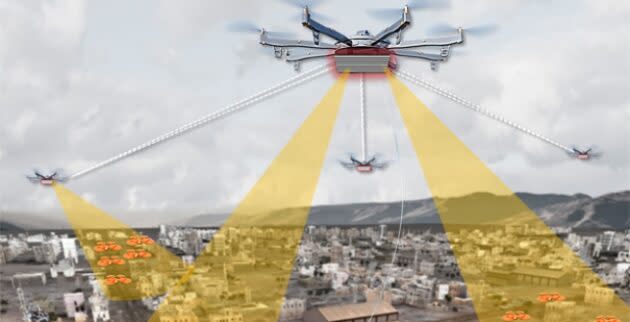Echodyne and Univ. of Washington assist DARPA with aerial drone surveillance test

When the Pentagon’s Defense Advanced Research Projects Agency tested an “Aerial Dragnet” system for tracking drones over urban terrain last month, Echodyne lent a helping hand.
Echodyne — a Kirkland, Wash.-based startup backed by Microsoft co-founder Bill Gates — provided the compact radar systems for DARPA’s tests during the week of Oct. 23 in the San Diego area, in conjunction with the University of Washington’s Applied Physics Laboratory.
The Aerial Dragnet exercise involved putting Echodyne’s EchoGuard and EchoFlight flat-panel radar systems on two large tethered aerostat balloons that flew as high as 400 feet, as well as on rooftops and towers around San Diego and National City.
DARPA then sent up several types of drones for the systems to detect and track. A key challenge involved being able to distinguish the drones from other objects in the background, including ground vehicles and birds.
“The DARPA requirement to create full urban airspace situational awareness has been challenging yet rewarding,” Tom Driscoll, Echodyne’s chief technology officer, said in a news release. “In conjunction with APL-UW, we operated more than a dozen radars on aerostats and rooftops to detect and track urban drone flights.”
San Diego was well-suited for the test because it’s one of 10 regions that have been cleared by the U.S. Department of Transportation for drone pilot projects — and also because it’s home to the U.S. Navy’s largest base on the West Coast.
DARPA’s interest in the technology relates primarily to protecting U.S. military personnel from urban drone attacks overseas. But the system also could guard against unauthorized drone flights, including potential terrorist attacks, in U.S. metropolitan areas as well.
“Our performance demonstrated that Echodyne’s innovative, beam-steering, electronically scanning radars have unique operational, sensitivity and intelligence characteristics necessary to conduct networked airspace surveillance over a major U.S. city like San Diego,” Driscoll said.
Echodyne’s radar systems require no moving parts because they take advantage of specially engineered structures known as metamaterials. Such structures can be electronically programmed to bend electromagnetic beams in different directions.
In September, Gates and other investors contributed to a $20 million funding round for Echodyne, with a focus on responding to rising demand for the EchoGuard surveillance radar system.
Gates has invested in several other metamaterials ventures spun out from Bellevue, Wash.-based Intellectual Ventures, including Kymeta for satellite antennas, Evolv for security scanners, Pivotal Commware for terrestrial wireless applications and Lumotive for laser scanning devices.
More from GeekWire:
Fortem vs. Echodyne? Super Bowl could host battle of drone-seeking radar systems
Backed by Bill Gates, Echodyne plays role in a pioneering flight of a drone on its own
Echodyne seeks thumbs-up from FCC for Super Bowl test of drone-detecting radar
Echodyne raises $20M from Bill Gates and others as surveillance radar gains traction
